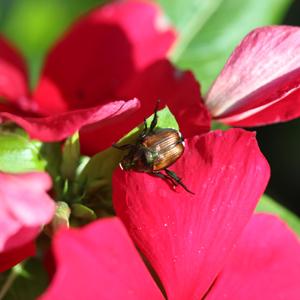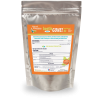Learn how to prevent a beetle invasion
Have the Japanese Beetles invaded your lawn yet? Get ready. They’re coming – just like they do every July!
Many of the adult beetles will be flying and laying eggs by late June and for most of the month of July. Therefore, eggs will be hatching over the next several weeks. Early to mid-August will be the time most likely for heavy grub activity. At this time the grubs will begin feeding on grass roots. While damaging symptoms may not appear right away, discolored patches of turf will appear in late August, September, and even into October.
Lifecycle

The Japanese beetle has a 1-year life cycle. In mid-June to July adults emerge from the soil, lay eggs and the larvae hatches.
Mating and the laying of eggs begin soon after adult emergence when young female beetles produce a potent airborne pheromone. Females mate, lay eggs, and mate again. Areas with moist, loamy soil covered with well-maintained turf are preferred breeding grounds, especially when sites are near favored food plants. Preferred hosts are lindens, purple-leaf plum, Norway maple, fruiting trees, roses, and hibiscus.
Eggs hatch in about two weeks. The young grubs, about the size of a grass seed, begin feeding on fine plant roots and organic matter. In late summer, most grubs will be in the upper 2 inches of soil.
Damage
The Japanese beetle is among the worst pests of turfgrass and woody landscape plants in the eastern United States. Their damage appears from late August to early October, after the grubs have eaten turf roots.
Typical signs of grub damage include “drought like” patches of wilted, dead, or dying turf visible during spring and fall. In addition to grass, the adult beetles attack ornamental plants, feeding on the upper leaf surface, leaving a lace-like skeleton of veins. Damaged leaves turn brown, die, and drop off.
Grub Weather
As a rough guideline to determine the magnitude of grub problems in your area, monitor weather conditions during the last two weeks in June and the first few weeks in July. The critical factor is moisture levels. Egg survival is dependent on having enough moisture. When the young larvae hatch, they are dependent upon moisture for survival. If the weather is wet or moist during this period, you can expect a potential grub problem in late summer and fall. Hot dry weather during late June and early July will usually dehydrate many of the eggs causing a lower grub population that year.
Controlling Japanese Beetles Naturally

Milky Spore is a naturally occurring beneficial bacteria that begins working upon application wherever grubs are feeding. It is 100% organic and OMRI (Organic Materials Review Institute) listed. It is approved and registered with the EPA, and it is acknowledged by the USDA as a safe, long-term control of Japanese Beetle Grubs. It is not harmful to beneficial insects, birds, bees, pets, or humans and will not affect wells, ponds or streams.
The time to act is NOW! It would be significantly more beneficial to apply this product prior to the activity, rather than later. However, it is equally important to understand that this product may be applied at any time as long as the ground is not frozen.
One 10 ounce container treats 2,500 square feet. Our 40 ounce container treats 10,000 square feet.
beetleGONE!® is effective at controlling existing adult beetles safely during the mid-summer months. Most beetles have a one-year life cycle, June Beetles have a three-year cycle. Control these unwanted beetles from your landscapes, turf and ornamental beds without chemical side effects, or harm to beneficial insects such as bees, earthworms and other pollinators.



